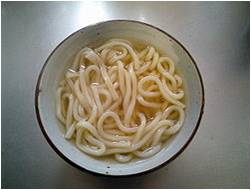THE ART OF SLURP …
2010年01月28日

As a child, my parents would have had a blue fit if any of us slurped soup, no matter how tasty. It just wasn’t and still isn’t done. Not here in Kagawa, and certainly not with the specialty of Kagawa; udon! And tasty it really is and this man has been adroitly seduced by the slippery, wet stuff. Udon noodles are served (usually hot) in bowls with the dashi (stock) with condondiments to suit tastes. Ginger, hot pepper powder, grated radish, mirin and sesame are perennial favorites and used throughout the four seasons. Udon’s taste is subtle but believe me it grows on you… I was a bowl-a-day man for a few years there and at the low price it’s an easy and wonderful habit. I was going to tell a story about an old girlfriend who used to bite off pieces, do something inside her mouth which I still cannot understand, then pull it out tied in a knot. But I’m digressing …
Chilled in the summer, hot in the winter:
Some varieties are hot, plucked from a communal bowl and dunked in a sauce made of ‘dashi’ and soy sauce. Others have toppings of tofu, some topped with tempura (deep fried veggies or shrimps etc.) The simpler the better I reckon and the price is ridiculously cheap, around 400 yen a serve with a topping. We could talk all day about the varieties of udon, for there are heaps of them but the basics should suffice.
Kagawans insist theirs is the true udon and I have to agree, as there is something unique about the taste of the local stuff that isn’t quite the same anywhere else in Japan. It’s true, it is a little different and the taste? In two small words; subtle and unique. All right, let’s throw in ‘very good’ and ‘a bit unusual’. There is a definite difference in taste between the hand-made udon noodles and machine made ones.
Restaurants in Kagawa are p-e-n-t-i-f-u-l, especially around train stations. All one has to remember is to look for signs with the Japanese letters written below. So, if you’re unfamiliar with the Japanese language, then why not cut this out now and carry it in your wallet?
うどん

I hope you’ll try to remember the word and the characters above even if you aren’t a Japanese speaker. This signs will be everywhere. Please do drop in and try this wonderful food. Start with a basic simple dish like the one bellow with just some green onions, sesame seeds and a dash of ginger for the basic taste. Next time perhaps, be adventurous and experiment with different toppings. Most of all, don’t be afraid to slurp! It’ll be a welcome noise of appreciation for the cooks and staff.
Posted by pat at
09:00
│Tasty Foods
The Art of Snip ...
2010年01月21日

A little quote from the Official Kinashi Web Site“[Kinashi] is so unpopular name in Japan. [KI] shows the Japanese name of ogre. [NASI] is non. We usually called the people of pirate as a ogre in old time. Thus, Kinashi might be the safe place even from pirate peoples from old time. Bonsai must be one way to keep Peace of Mind from the old time. Old people in Kinashi might try to feel kind to others from growing Bonsai.”
And peace of mind it most certainly is ... Located about 15 minutes away by car and less by JR train to the west of Takamtasu is the town of Kinashi. It’s even possible to rent a bicycle from the rent-a-bicycle-service right near the Takamatsu Central Station and ride out there. If you do decide to go by train to the very small Kinashi station, in the station building there’s a ‘Kinashi Nursery Map’ with the locations of many nurseries, however one must have permission to enter these places, so a little pre-visit research or help on how to best go about this from the I-Pal international enter is a good idea.
Kinashi has always been a quiet place, a bit of a bed town as they say in Japanese, but what it’s really famous for is the wonderful bonsai nurseries that are spread out everywhere. An older couple once old me that the area looked like a moon landscape after the war from the pounding it took from the Allied bombing, but it’s certainly nothing like that these days and well worth a visit to see. The nurseries themselves are easy to see, as they’re not usually fenced very much.
This is a town with a lot of history; even more bonsai and some families have been at it for 4 or more generations. Bonsai practitioners quietly go about ‘training’ and cultivate their trees, some of which are over 250 years old and the process is one with much love, affection and respect for the trees themselves.
Through the invitation of a foreign friend who was studying at a Kinashi nursery, I once watched a master artist pruning a very old tree. Snip, snip, snip then he’d hold the potted tree back for critical appraisal, a few more snips, put it down and walk back for another look. Even to watch, meditative, quiet and very refreshing for the tired soul.





